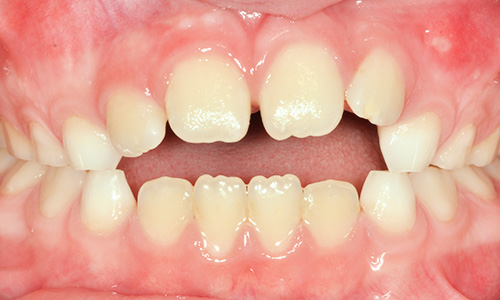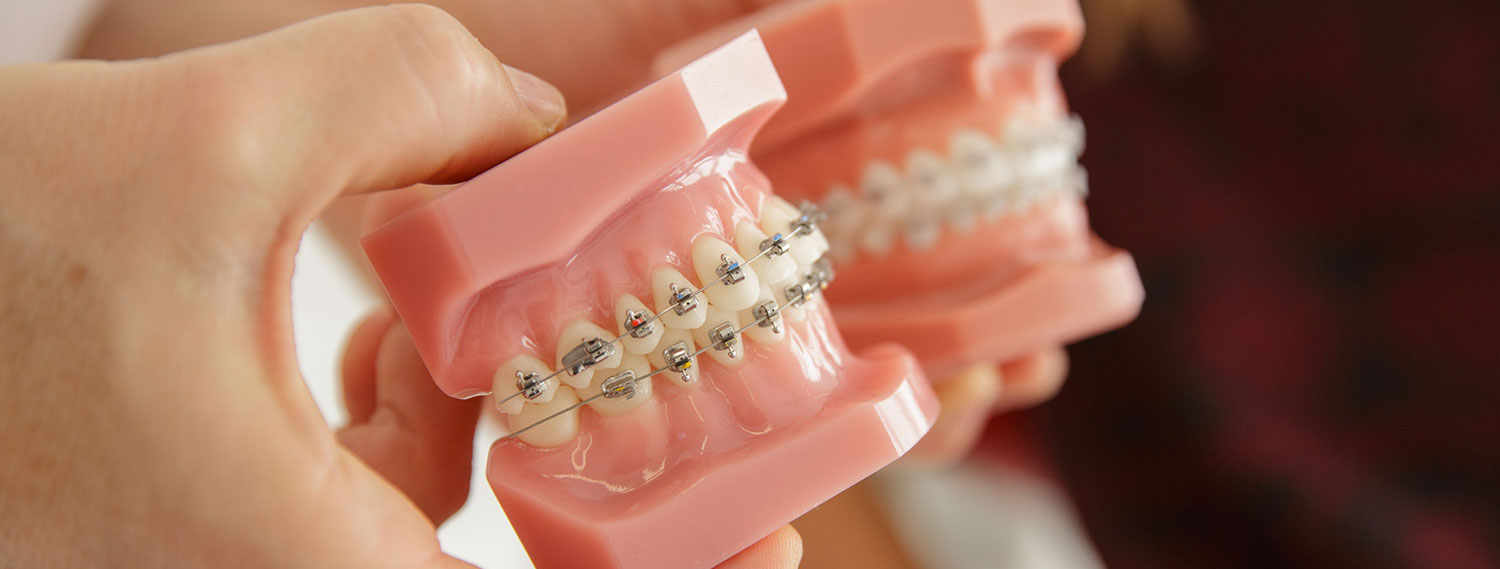
for your Kids
Braces - the “influencer” for healthy children's teeth in the Canton of Solothurn
Our hearts fill with joy when we see the bright smiles of children. This should be taken for granted but quite often it is not. Children with crooked teeth or large gaps are often bullied by other children. Straight and healthy teeth help develop stronger confidence. So what to do if some teeth step out of line? Or if the gap once considered cute becomes larger? This is the moment when children’s teeth need some intervention ensuring that they are positioned perfectly in the long term – and ensuring the innocent smile of your child
- The school’s dentist recommends braces for your child?
- You wonder whether an orthodontic treatment could be useful?
- What do you and your child have to expect?
Our specialist orthodontic, Med. dent. Kristina Sleiter-Bajic, will take all the time necessary to advise you and your child. Together with her team, she will explain to you in detail:
- how to avoid that dummy and thumb shift the teeth,
- why crooked teeth can lead to health problems,
- from which age onward braces are useful and how the orthodontic therapy is carried out.
Call nowThere are many options to correct teeth in a gentle way. Together we will find the best solution for your children. Give us a call and book an appointment at our clinic in Egerkingen:
Straight teeth for strong and healthy children
Crooked teeth do not only have negative impacts on children’s confidence. Twisted or very narrow teeth can cause health problems:
- The risk of developing tooth decay and similar diseases increases because very narrow teeth cannot be brushed very well.
- Where teeth in the upper and lower jar do not fit well, the mandibular joint of your child will be strained causing headaches and neck pain.
- Does your child lisp? Misplaced teeth often affect the way we speak.
Do your child’s teeth grow crooked? Is the jaw’s position asymmetrical? There are numerous options available to positively influence the growth of teeth and jaw bones of children and teenagers.
You wonder how braces work?For detailed information, please visit the “general orthodontics” section.
When should you take your child to see an orthodontic dentist?

Ideally, we check that your child’s teeth and jaws are developing well before the age of 10. At this time, the teeth are in a transition period. What exactly does that mean? The first milk teeth are shed and the “second” permanent teeth start to grow.
Now we can see:
- if the permanent teeth find enough space in the jaw,
- if they grow straight,
- if upper and lower jaw develop symmetrically.
Does your child have extensive dummy or thumb sucking habits? They both influence the development of the jaw and the first milk teeth. This can be recognised as early as at the age of 4. Do the first milk teeth grow in crooked way? It is very important to take the necessary countermeasures in due time. This can help your child avoid complex tooth corrections at a later age.


We are happy to explain to you what gentle preventive measures are available to help you wean your child off the thumb or dummy.
From the age of 10, braces achieve good results.
Your school dentist will examine how your child’s teeth are growing and how the jaw is developing during the annual check-up. Should the school dentist recommend a visit at the orthodontist, please make an appointment with us.
Between the ages of 10 and 12, the jawbone grows very quickly. During this time, good results can be achieved with removable and fixed braces as they can actively push teeth and jaw bone in the right direction.
From the age of 14 onward, we usually recommend fixed braces. The jaw grows more slowly. With fixed braces, we can move the teeth more effectively into the right position. Your child doesn’t like the idea of having a wire frame in the mouth? Today there are discreet, tooth-coloured braces and brackets available. Furthermore, we help your child getting used to the braces.
Call nowBook an appointment now and set the course for straight children’s teeth. Call us:
Orthodontic treatment of children and teenagers in Egerkingen

Your child will be the focus of our practice, we will explain every step of the treatment in an age-appropriate way.
During the first appointment, Med. dent. Sleiter-Bajic will examine your child’s teeth and jaws. She will examine the mandibular joint and the connected muscles and find out whether the teeth are crooked or if your child puts a wrong strain on the jaw.
Then, technology sets in: we take pictures of the teeth with a camera. After that we x-ray the jaw.
The images show:
- the teeth’s positioning in the jaw,
- the teeth’s grow status,
- the jaw bone’s development status.
Together, we will discuss the results. Is it necessary to correct the teeth of your child? If we recommend an orthodontic therapy, we will discuss with you:
- which braces are going to be used,
- the duration of the therapy,
- the costs of the therapy.
Removable, fixed or (almost) invisible braces – which model is the right one for your child? We will explain to you which braces are most suitable.
Removable braces

Does your child still have his/her milk teeth? Removable braces are a good solution. With gentle pressure, they influence the growth of the jaw bone and the newly growing teeth. There are various models available and we will be happy to show them to you in a personal meeting.
The greatest advantage of this variant is, at the same time, its greatest disadvantage: it’s up to your child to take the braces out. This would be perfect for cleaning the teeth. However, children tend to remove the uncomfortable braces while playing or at school. Unfortunately, this interrupts the treatment again and again and prolongates the therapy.
Maybe the palatal plate of your child’s braces causes discomfort while eating and speaking. This will wear off after some time. Our team is ready to help your son or
daughter with many useful tips and hints so he or she will continuously wear the braces with ease.
Fixed braces

Fixed braces remain in the mouth. Fixed braces consist of three components:
- The brackets are glued onto the teeth and serve the purpose to fasten bands and wires. They can be made out of metal or almost transparent ceramic.
- Metal bands instead of brackets are attached around the large molars to enable an effective moving process.
- Rubber straps and metal wires in the small slots are connected to the brackets and are regularly adjusted. This method ensures that the teeth are moved very slowly into the desired position.
Retainer

Once your child’s teeth are in the right position, we have to take care that they will remain in this position in the long term – by using so called retainers. The teeth have to get used to their new location. They have a habit to shift back to their old, accustomed position. This is prevented by a retainer.
There are removable retainers your child has to wear only at night. Fixed retainers, usually a small wire, are placed invisibly at the back of the anterior teeth. Whether the solution should be removable or fixed, is something we will decide together at the end of the orthodontic treatment.
Braces and clean teeth?
Find all experts under one roof in the Dentalspecialist clinic. Find more information how we take care of your children’s dental health with regular prophylaxis.
Frequently asked questions about children's braces
Any questions? Here you find the answers to the most common questions. If you don’t find the information you are looking for, just book an appointment – without any obligations for you.
What are the costs of an orthodontic treatment for my child?
Usually, children’s braces are not covered by the Swiss basic insurance scheme, except for severe diseases or malposition. In such cases, the professional orthodontist, Med. dent. Sleiter-Bajic, is entitled to settle bills directly with the relevant Swiss accident, military and disability insurance.
Many parents take out a supplementary dental insurance for their children which covers the costs of orthodontic corrections. We will be happy to provide you with the relevant documents required to apply for cost coverage. After each step of the treatment, we will supply a transparent invoice for submitting.
What are the costs of the correction? This depends on the individual case. How many teeth have to be corrected? Which type of braces do you select? What is the duration of the therapy? We will discuss all these questions together with you during the first appointment. You will receive a detailed therapy plan from us so that you have an exact overview of the costs to be expected. We do not facilitate collective invoices but will invoice the individual service of each step in the therapy plan. This ensures that the separate invoices are easier to comprehend.
The treatments will be invoiced according to the insurance tariffs of the Swiss society of dentists (SSO). The rate conversion factor (Taxpunktwert) for orthodontic therapies in our clinic is 1.05 CHF. If you wish so, you can pay in individual instalments. We will find a solution to give your child a healthy and confidential smile
For how long does my child have to wear the braces?
Usually, the duration of the therapy is between 12 and 24 months. Many factors play a certain role: how many teeth are affected? Fixed or removable braces? How good is your child’s compliance of wearing removable braces? We will look at everything, and you will receive a detailed prognosis before we start the therapy.
How often does my child have to visit you for check-ups?
Regular check-ups are extremely important so that together we can ensure the success of the therapy. Removable braces will be controlled approximately every two months. Fixed braces have to be checked every 4 to 8 weeks, depending on whether we have to adjust or retighten rubber bands and wires. After each appointment, we will schedule the next visit.
Do fixed braces impact the dental enamel?
Fixed braces, as well as removable ones, require the cooperation of your child. Regular tooth brushing is extremely important to remove any food particles stuck in the brackets. We explain to your child the best tooth brushing techniques. During the check-ups, we will always control whether all teeth are clean and healthy. Braces do not impact the dental enamel. The latest brackets are tooth-friendly. If required, we will seal individual teeth or carry out regular professional cleanings.
How important is hygiene for milk teeth? There will be new teeth anyway?
Milk teeth are an important placeholder for the final teeth. So, you should clean your child’s milk teeth as thoroughly as your own teeth. If milk teeth fall out too early, the adjacent teeth might grow crookedly into the gap. In the worst case, the jaw bone does not develop correctly because there is no pressure of the missing teeth.
This is why it might make sense to use braces in order to shift the milk teeth into the right position.
Any questions?Call nowWe will be happy to advise you. Book an appointment now. Call us:
